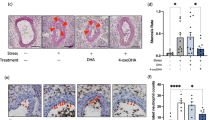Abstract
Cardiovascular and cerebrovascular disorders are well known to be associated with stress related behaviors. Stress enhances excretion of adrenaline, which is deaminated by monoamine oxidase and methylamine is formed. This product can be further deaminated by semicarbazide-sensitive amine oxidase (SSAO) and converted to toxic formaldehyde, hydrogen peroxide and ammonia. SSAO is located in the cardiovascular smooth muscles and circulated in the blood. We investigated whether formaldehyde can be derived from adrenaline in vivo. Methylamine was confirmed to be a product of adrenaline catalyzed by type A monoamine oxidase (MAO-A). Irreversible and long-lasting radioactive residual activity was detected in different tissues following administration of 1-[N-methyl-3H]-adrenaline. Such irreversible linkage could be blocked by selective MAO-A or SSAO inhibitors. Endothelial cells are quite sensitive to formaldehyde and relatively resistant to hydrogen peroxide. It is possible that stimulation of adrenaline excretion by chronic stress could increase the levels of circulatory formaldehyde. Such chronic “formaldehyde” stress may be involved in the initiation of endothelial injury and subsequently angiopathy.
Similar content being viewed by others
REFERENCES
Frankenhaeuser, M. 1971. Behavior and circulating catecholamines. Brain Res. 31:241–262.
von Euler, U. S. 1976. Adrenal medullary secretion and its neural control. pp 283–333 in Martini L., and Ganong W. F., (eds) Neuroendocrinology Vol. 2, New York: Academic Press.
Yu, P. H. 1986. Monoamine Oxidase. in Boulton, A. A., Baker, G. B., and Yu, P. H., eds. Neuromethods Volume V: Neurotransmitter Enzymes. New Jersey: Humana Press, Clifton, pp 235–272.
Yu, P. H. 1990. Deamination of aliphatic amines of different chain lengths by rat aorta semicarbazide-sensitive amine oxidase. J. Pharm. Pharmacol. 42:882–884.
Precious, E., Gunn, C. E., and Lyles, G. A. 1988. Deamination of methylamine by semicarbazide-sensitive amine oxidase in human umbilical artery and rat aorta. Biochem. Pharmacol. 37:707–713.
Lyles, G. A., Holt, A., and Marshal, C. M. S. 1990. Further studies on the metabolism of methylamine by semicarbazide-sensitive amine oxidase activities in human plasma. J. Pharm. Pharmacol. 42:322–338.
Boor, P., Trent, M. B., Lyles, G. A., Tao, M., and Ansari, G. A. S. 1992. Methylamine metabolism to formaldehyde by vascular semicarbazide-sensitive amine oxidase. Toxicology 73:251–258.
Yu, P. H., Davis, D. A., and Boulton, A. A. 1992. Aliphatic propargylamines: potent selective irreversible monoamine oxidase B inhibitors. J. Med. Chem. 35:3705–3713.
Yu, P. H., and Zuo, D. M. 1993. Oxidative deamination of methylamine by semicarbazide-sensitive amine oxidase leads to cytotoxic damage in endothelial cells; Possible consequence for diabetes. Diabetes 42:594–603.
Matsumoto, Y., Uyama, O., Shimizu, S., Michishita, H., Mori, R., Owada, T., and Sugita, M. 1993. Do anger and aggression affect carotid atherosclerosis. Stroke 24:983–986.
Tagawa, R. R., and Hosaka, T. 1990. Study of the correlation between the type A behavior pattern in patients with coronary heart disease and the extent of coronary atherosclerosis. Tokai. J. Exp. Clin. Med. 1:45–50.
Gallacher, J. E., Yarnell, J. W., and Butland, B. K. 1988. Type A behavior and prevalent heart disease in the Caerphilly study: increase in risk or symptom reporting? J. Epidemiol. Commun. Health 63:226–231.
Mosmann, T. 1983. Rapid colorimetric assay for cellular growth and survival: Application to proliferation and cytotoxicity assays. J. Immunol. Methods 65:55–63.
Lyles, G. A., and McDougall, S. A. 1989. The enhanced daily excretion of urinary methylamine in rats treated with semicarbazide or hydralazine may be related to the inhibition of semicarbazide-sensitive amine oxidase activities. J. Pharm. Pharmacol. 41:97–100.
Yu, P. H., and Zuo, D. M. 1996. Formaldehyde produced endogenously via deamination of methylamine; a potential risk factor for initiation of endothelial injury. Atherosclerosis 120:189–197.
Dar, M. S., Morselli, P. L., and Bowman, E. R. 1985. The enzymatic systems involved in the mammalian metabolism of methylamine. Gen. Pharmacol. 16:557–560.
Baba, S., Watanabe, Y., Gejyo, F., and Arakwa, M. 1984. High-performance liquid chromatographic determination of serum aliphatic amines in chronic renal failure. Clin. Chim. Acta. 136:49–56.
Bolt, H. M. 1987. Experimental toxicology of formaldehyde. J. Can. Res Clin. Oncol. 13:305–309.
Grafstrom, R. C., Curren, R. D., Yang, L. L., and Harris, C. C. 1985. Genotoxicity of formaldehyde in cultured human bronchial fibroblasts. Science 228:89–91.
Gibson, J. E. (ed.). 1983. Formaldehyde Toxicity. Hemisphere Publ., Washington, New Jersey.
Cooper, J. R., and Kini, M. M. 1962. Editorial biochemical aspects of methanol poisoning. Biochem. Pharmacol. 11:405–416.
Tsuboi, S., Kawase, M., Takaka, A., Hirmatus, M., Wada, Y., Kawakami, Y., Ikeka, M., and Ohmori, S. 1992. Purification and characterization of formaldehyde dehydrogenase from rat liver cytosol. J. Biochem. 111:465–471.
Malorny, G. N., Rietbrock, N., and Schneider, M. 1965. The oxidation of formaldehyde to formic acid in the blood. A contribution to the metabolism of formaldehyde. Schmiedebergs Arch. Exp. Path. Pharmak. 250:419–436.
Helander, A., and Tottmar, O. 1987. Metabolism of biogenic aldehydes in isolated human blood cells, platelets and in plasma. Biochem. Pharmacol. 36:1077–1082.
Zuo, D. M., and Yu, P. H. 1993. Semicarbazide-sensitive amine oxidase and monoamine oxidase in rat brain microvessels, meninges, retina and eye sclera. Brain Res. Bull. 33:307–311.
Halliwell, B., and Gutteridge, J. M. C. (eds). 1989. Free radicals in biology and medicine. New York, N.Y. Oxford University Press.
Sackett, D. L., and Winkelstein, W. 1967. The relationship between cigarette usage and aortic atherosclerosis. Am. J. Epidemiol. 86:264–270.
Wilens, S. L., and Plair, C. M. 1962. Cigarette smoking and atherosclerosis. Science 138:975–977.
Cryer, P. E., Haymond, M. W., Santiago, J. V., and Shad, S. D. 1967. Norepinephrine and epinephrine release and adrenergic mediation of smoking-associated haemodynamic and metabolic events. N. Engl. J. Med. 295:573–577.
US Dept Health and Human Services. 1982. Constituents of tobacco smoke. USPHS Publication No. 82–50179, 322.
McKennis, Jr. H., Turnbull, L. B., Schwartz, S. L., Tamake, E., and Bowman, E. R. 1962. Demethylation in the metabolism of (−)-nicotine. J. Biol. Chem. 237:541–546.
Author information
Authors and Affiliations
Rights and permissions
About this article
Cite this article
Yu, P.H., Lai, CT. & Zuo, DM. Formation of Formaldehyde from Adrenaline In Vivo; a Potential Risk Factor for Stress-Related Angiopathy. Neurochem Res 22, 615–620 (1997). https://doi.org/10.1023/A:1022478221421
Issue Date:
DOI: https://doi.org/10.1023/A:1022478221421




